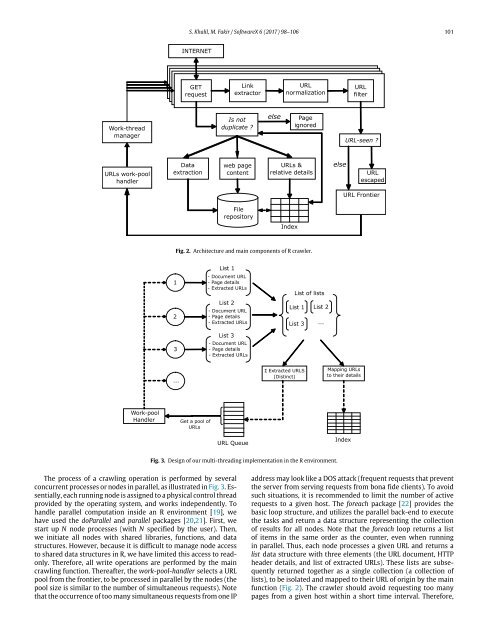how to build web crawler web scraper
Howto build a multi-threaded parallel web crawler web crawling book ebook scraper , key features and implementation web scraping paper research pdf web crawler design algorithm web scraper course architecture
Howto build a multi-threaded parallel web crawler web crawling book ebook scraper , key features and implementation web scraping paper research pdf web crawler design algorithm web scraper course architecture
You also want an ePaper? Increase the reach of your titles
YUMPU automatically turns print PDFs into web optimized ePapers that Google loves.
S. Khalil, M. Fakir / SoftwareX 6 (2017) 98–106 101<br />
Fig. 2. Architecture and main components of R <strong>crawler</strong>.<br />
Fig. 3. Design of our multi-threading implementation in the R environment.<br />
The process of a crawling operation is performed by several<br />
concurrent processes or nodes in parallel, as illustrated in Fig. 3. Essentially,<br />
each running node is assigned <strong>to</strong> a physical control thread<br />
provided by the operating system, and works independently. To<br />
handle parallel computation inside an R environment [19], we<br />
have used the doParallel and parallel packages [20,21]. First, we<br />
start up N node processes (with N specified by the user). Then,<br />
we initiate all nodes with shared libraries, functions, and data<br />
structures. However, because it is difficult <strong>to</strong> manage node access<br />
<strong>to</strong> shared data structures in R, we have limited this access <strong>to</strong> readonly.<br />
Therefore, all write operations are performed by the main<br />
crawling function. Thereafter, the work-pool-handler selects a URL<br />
pool from the frontier, <strong>to</strong> be processed in parallel by the nodes (the<br />
pool size is similar <strong>to</strong> the number of simultaneous requests). Note<br />
that the occurrence of <strong>to</strong>o many simultaneous requests from one IP<br />
address may look like a DOS attack (frequent requests that prevent<br />
the server from serving requests from bona fide clients). To avoid<br />
such situations, it is recommended <strong>to</strong> limit the number of active<br />
requests <strong>to</strong> a given host. The foreach package [22] provides the<br />
basic loop structure, and utilizes the parallel back-end <strong>to</strong> execute<br />
the tasks and return a data structure representing the collection<br />
of results for all nodes. Note that the foreach loop returns a list<br />
of items in the same order as the counter, even when running<br />
in parallel. Thus, each node processes a given URL and returns a<br />
list data structure with three elements (the URL document, HTTP<br />
header details, and list of extracted URLs). These lists are subsequently<br />
returned <strong>to</strong>gether as a single collection (a collection of<br />
lists), <strong>to</strong> be isolated and mapped <strong>to</strong> their URL of origin by the main<br />
function (Fig. 2). The <strong>crawler</strong> should avoid requesting <strong>to</strong>o many<br />
pages from a given host within a short time interval. Therefore,


